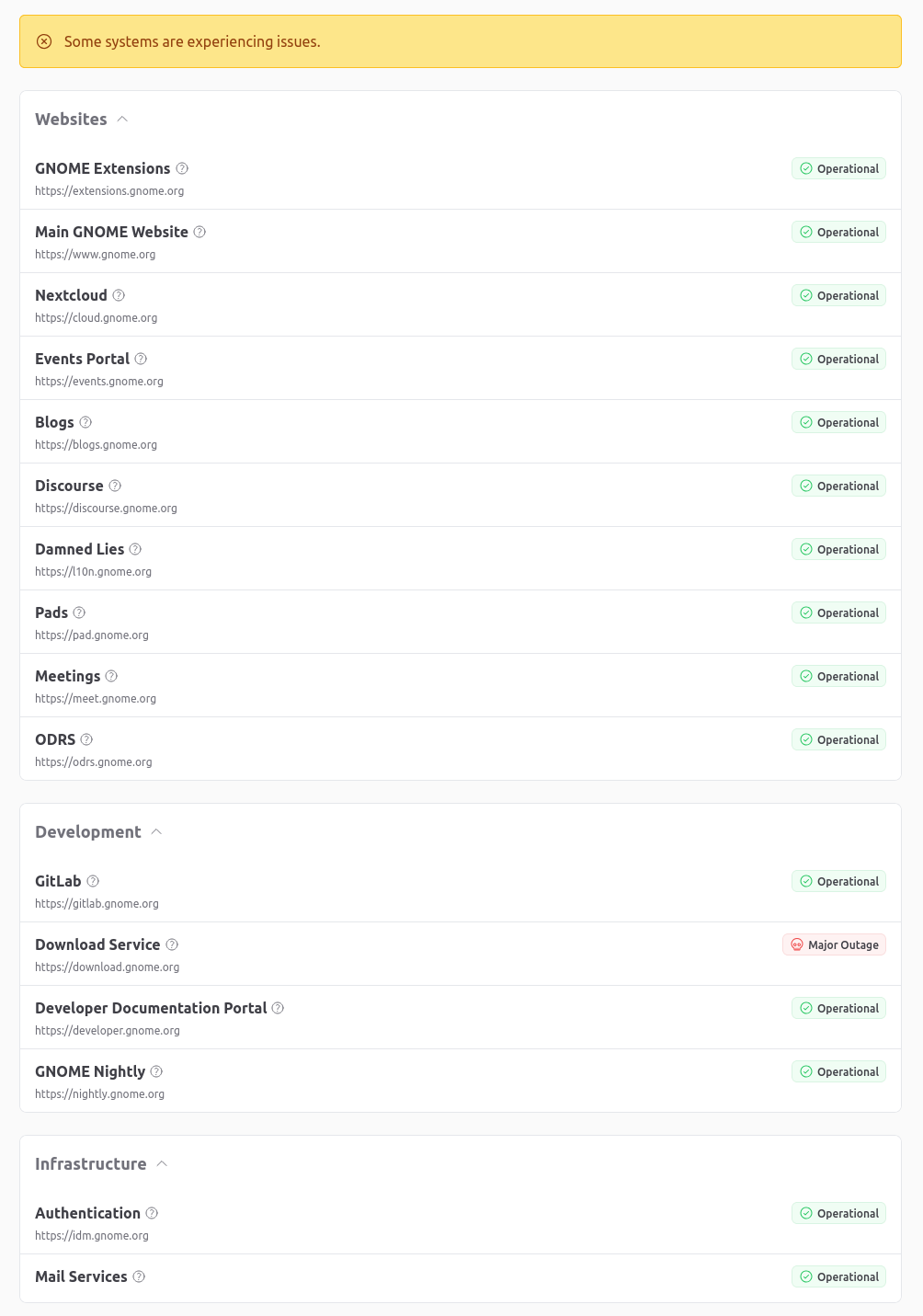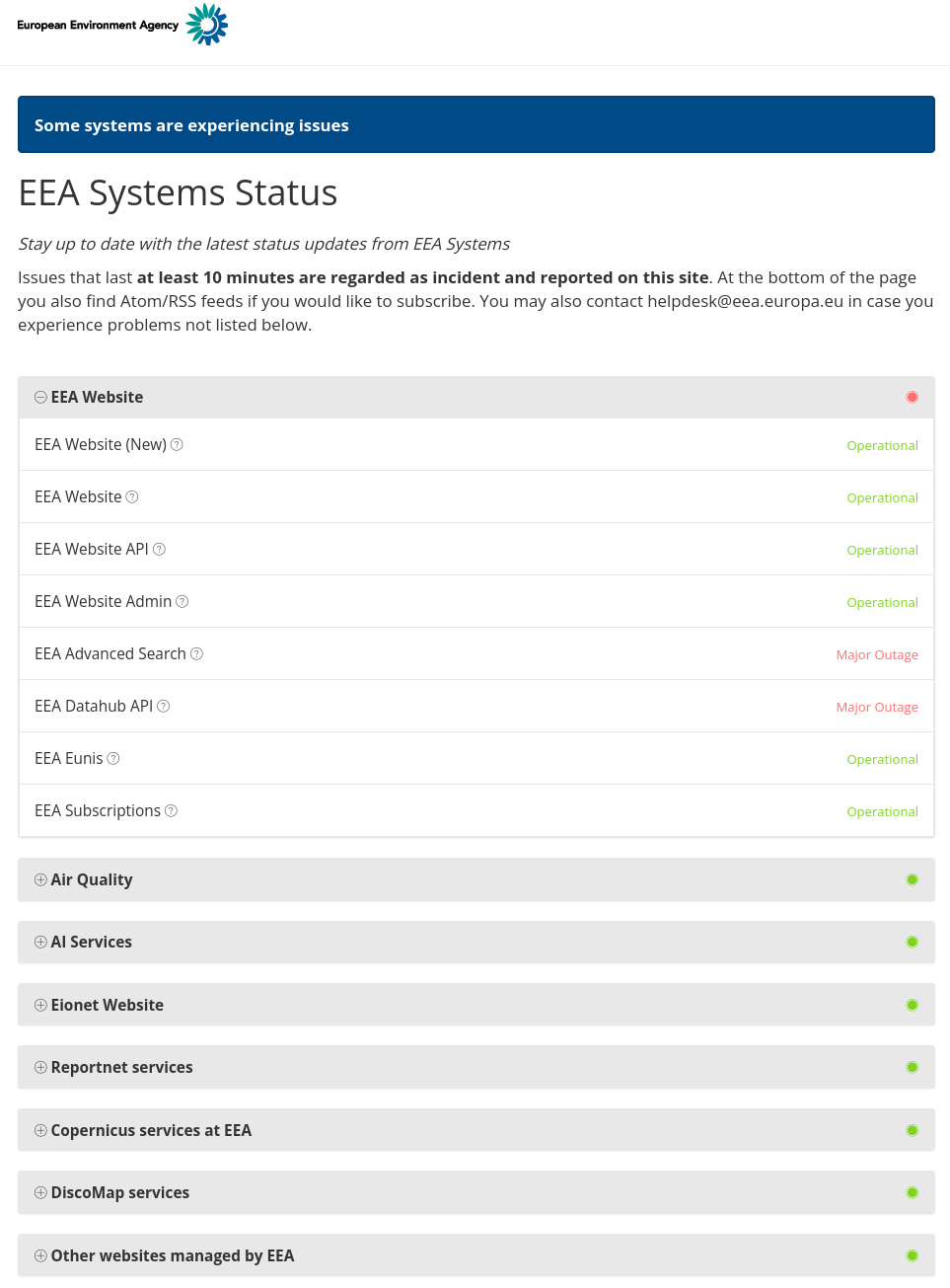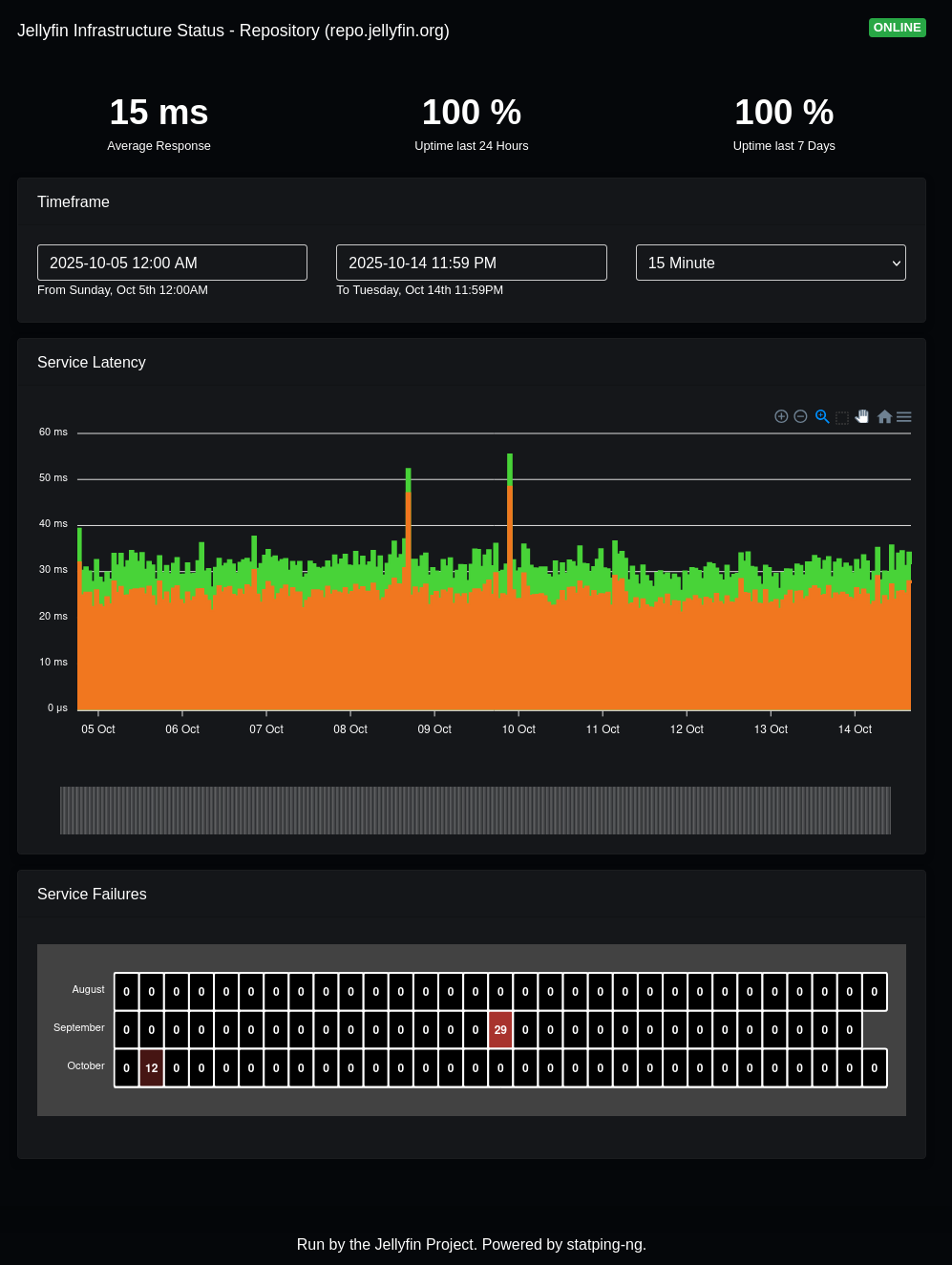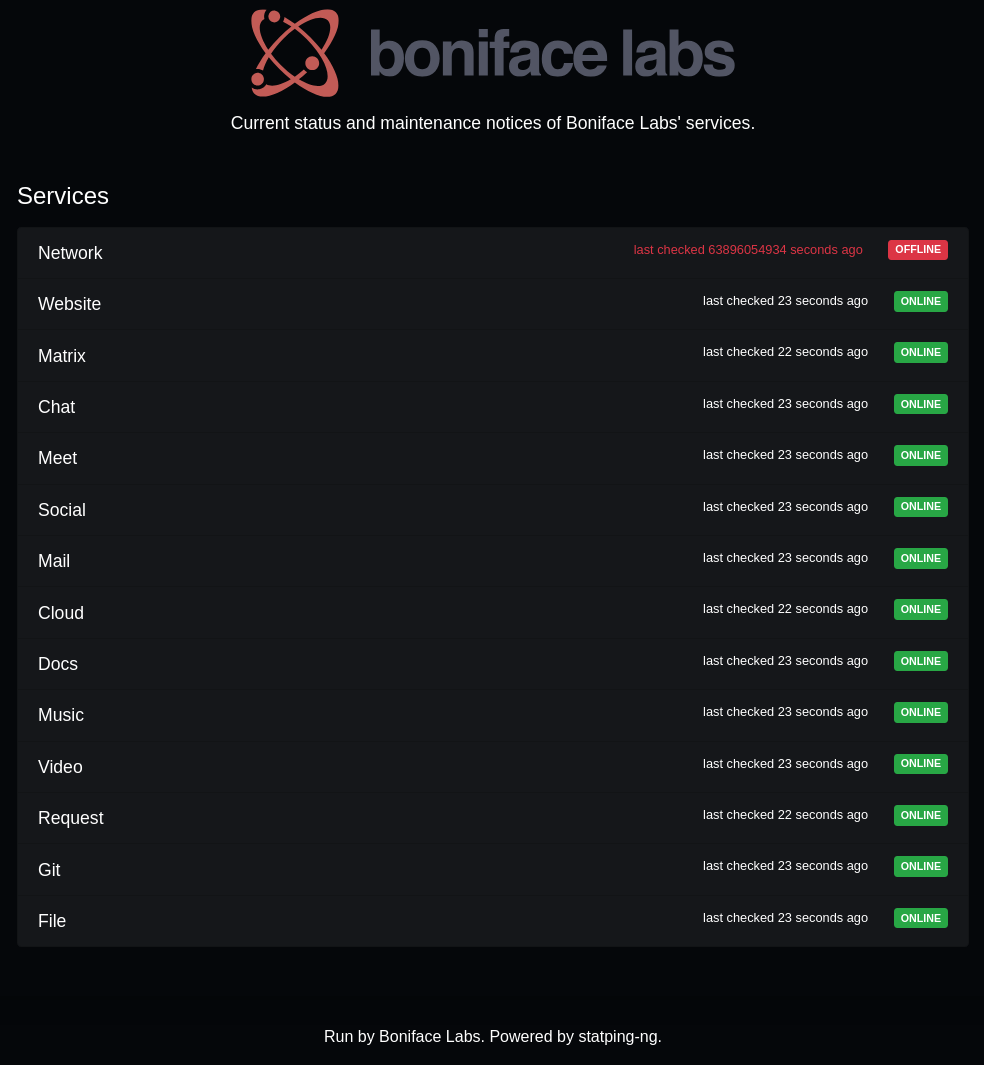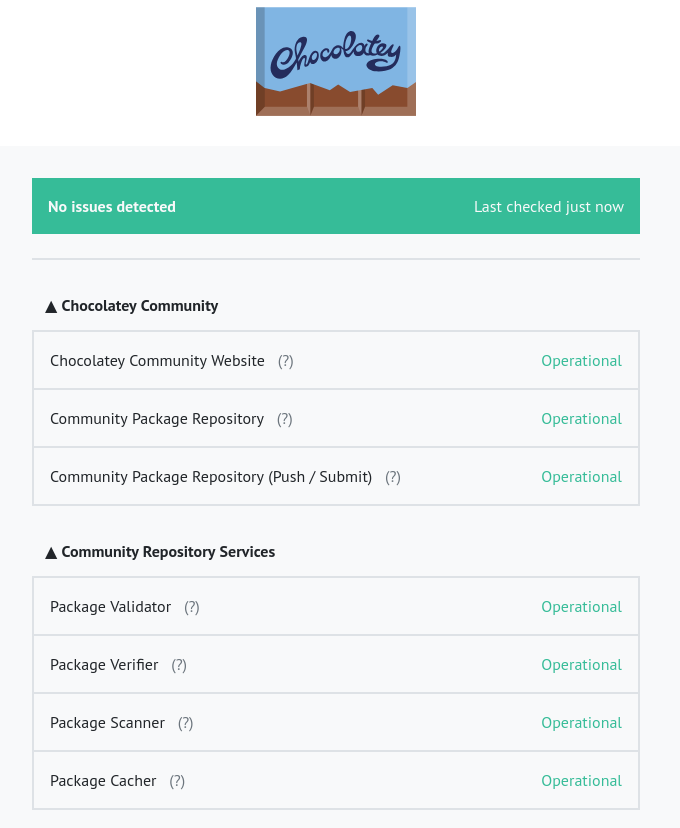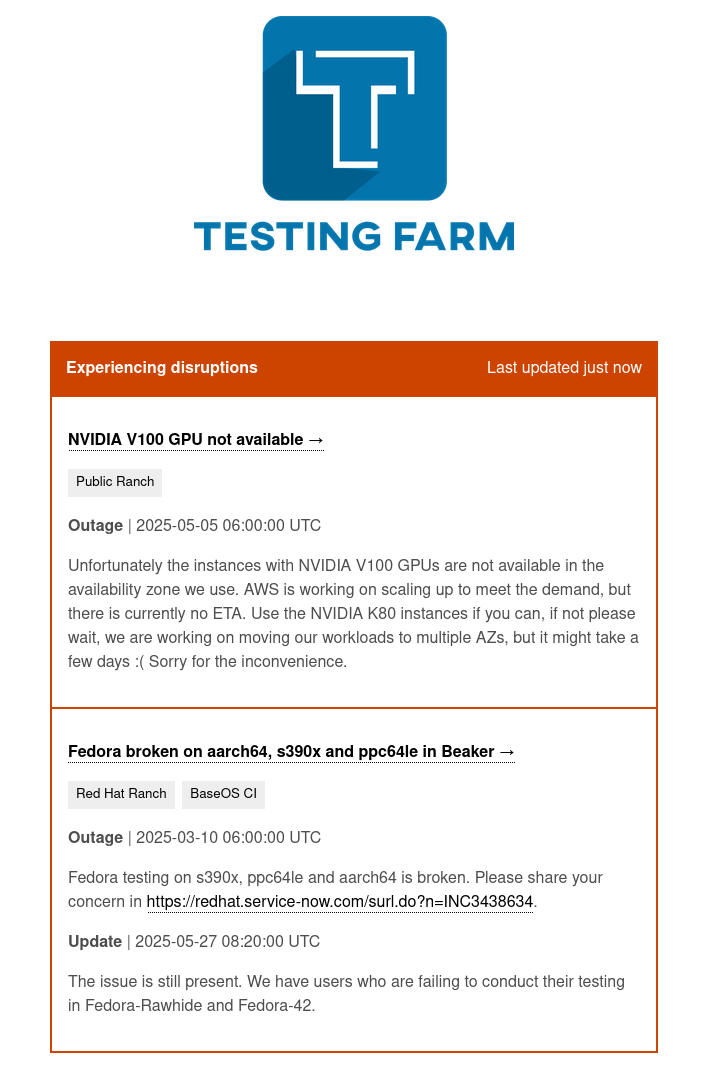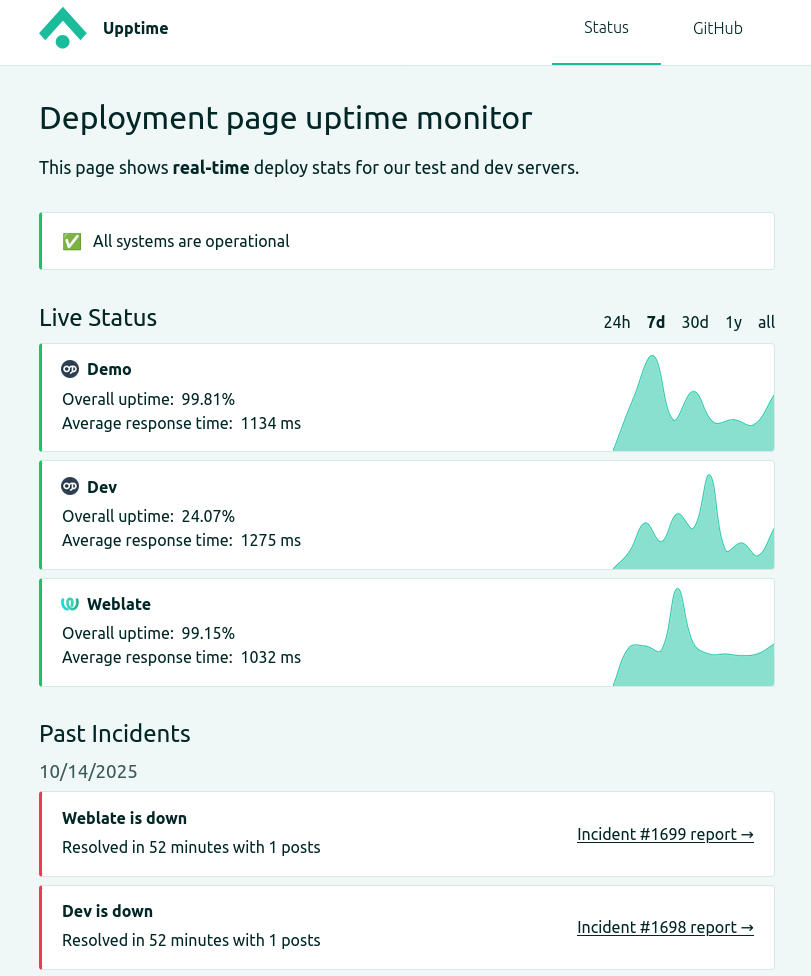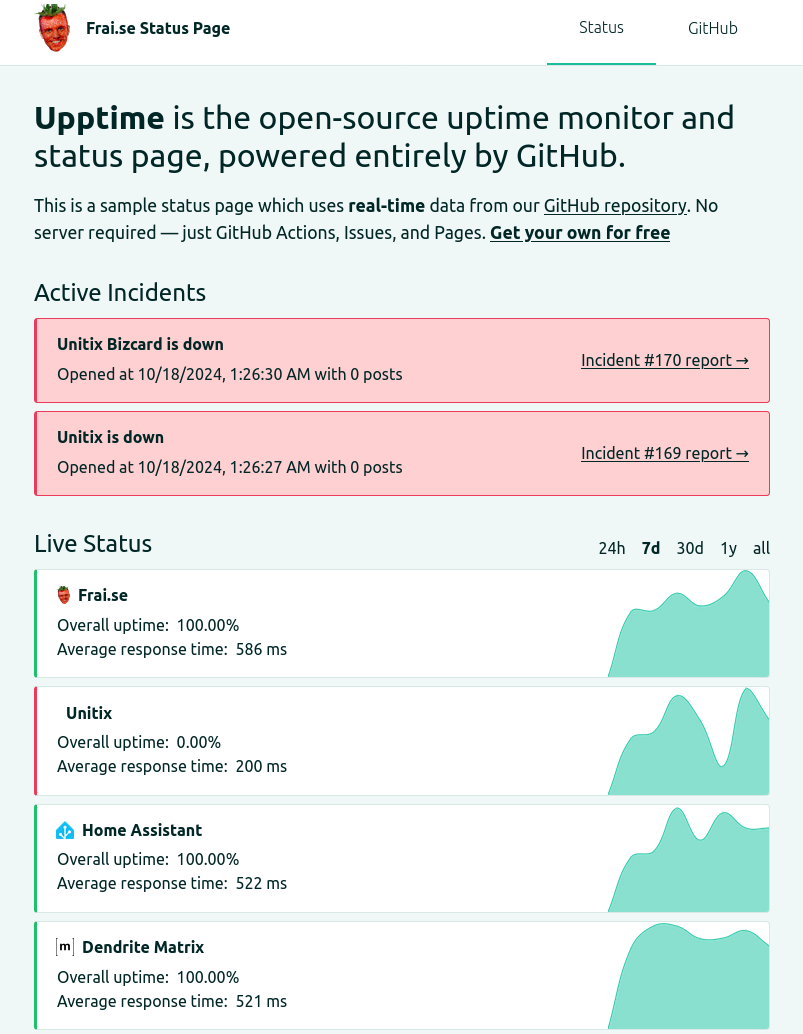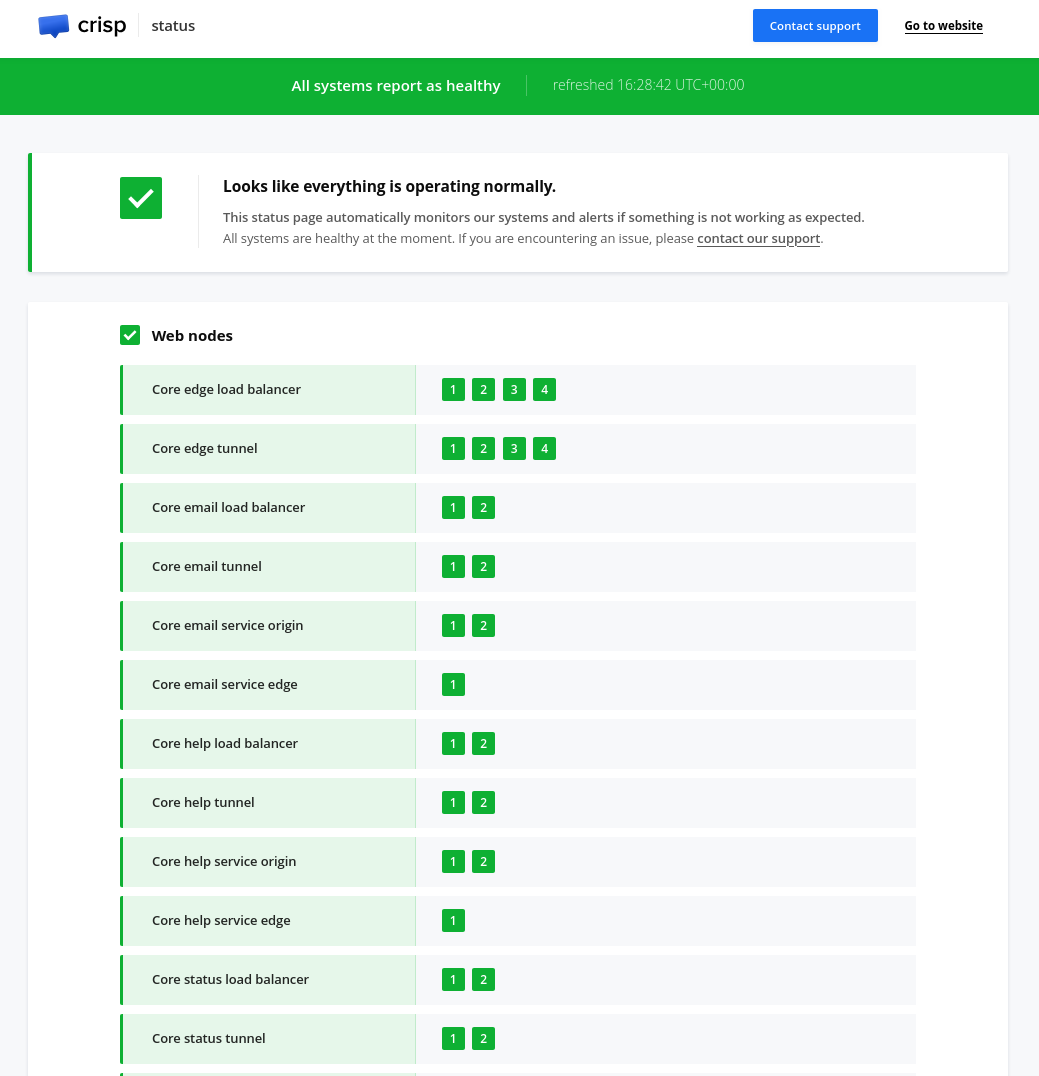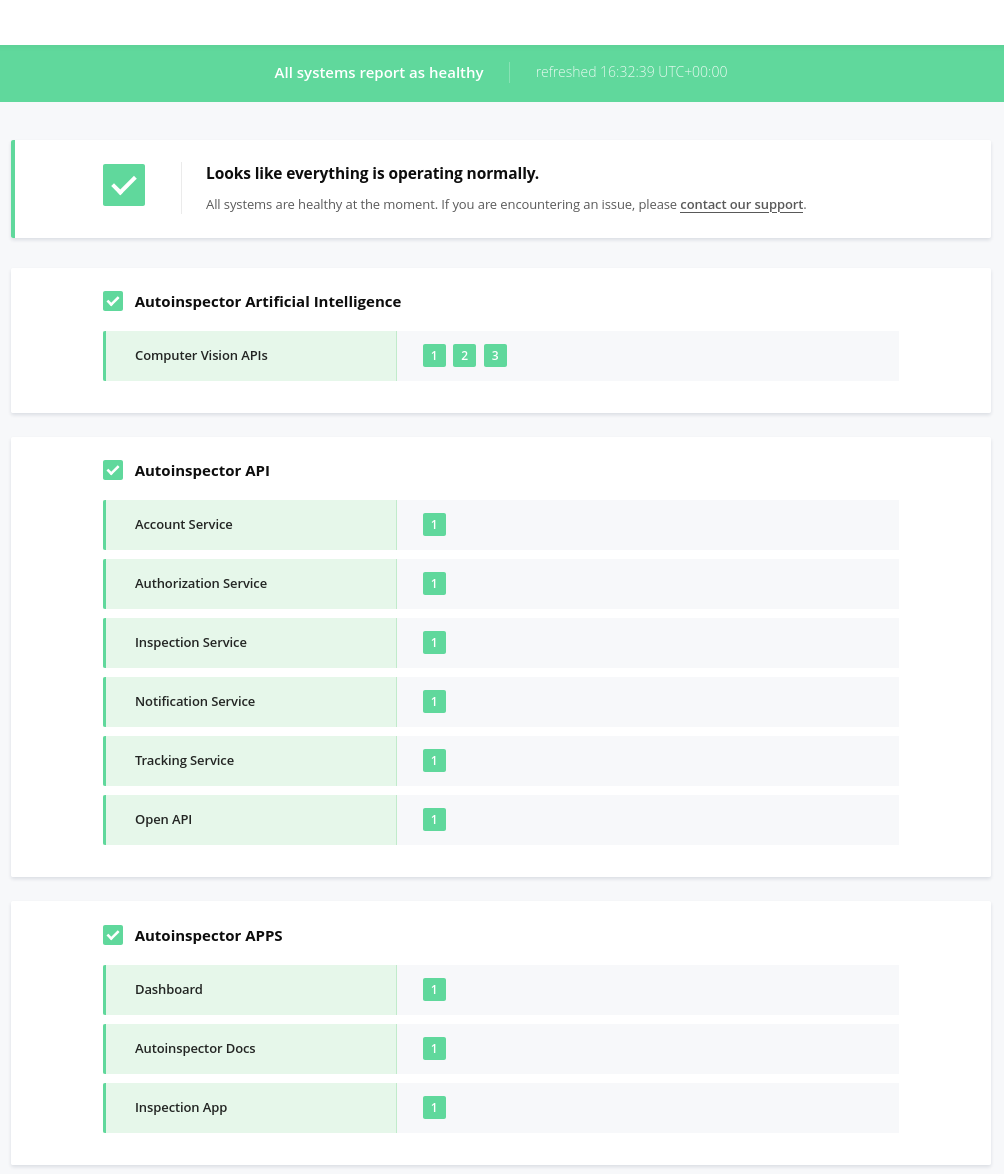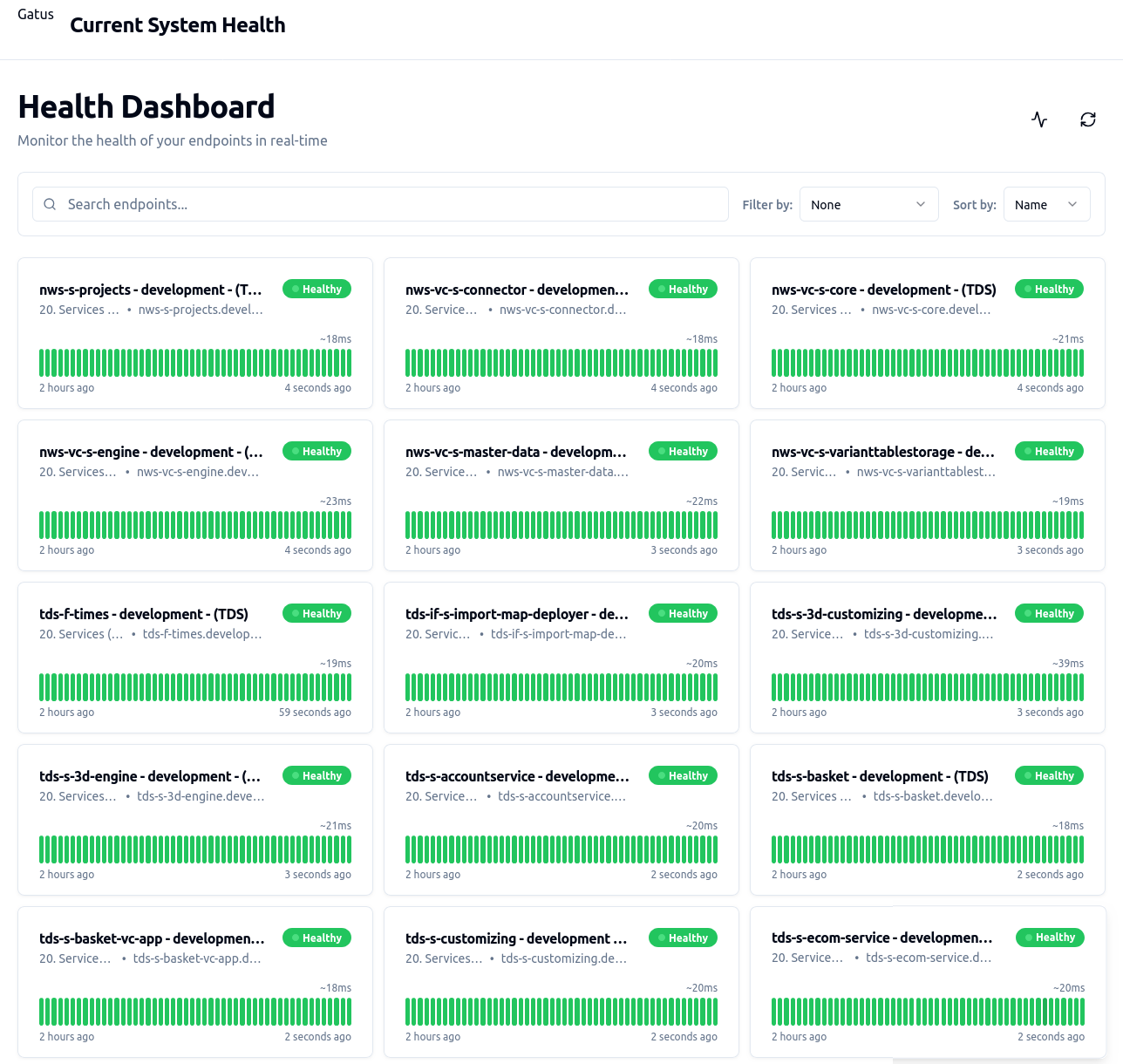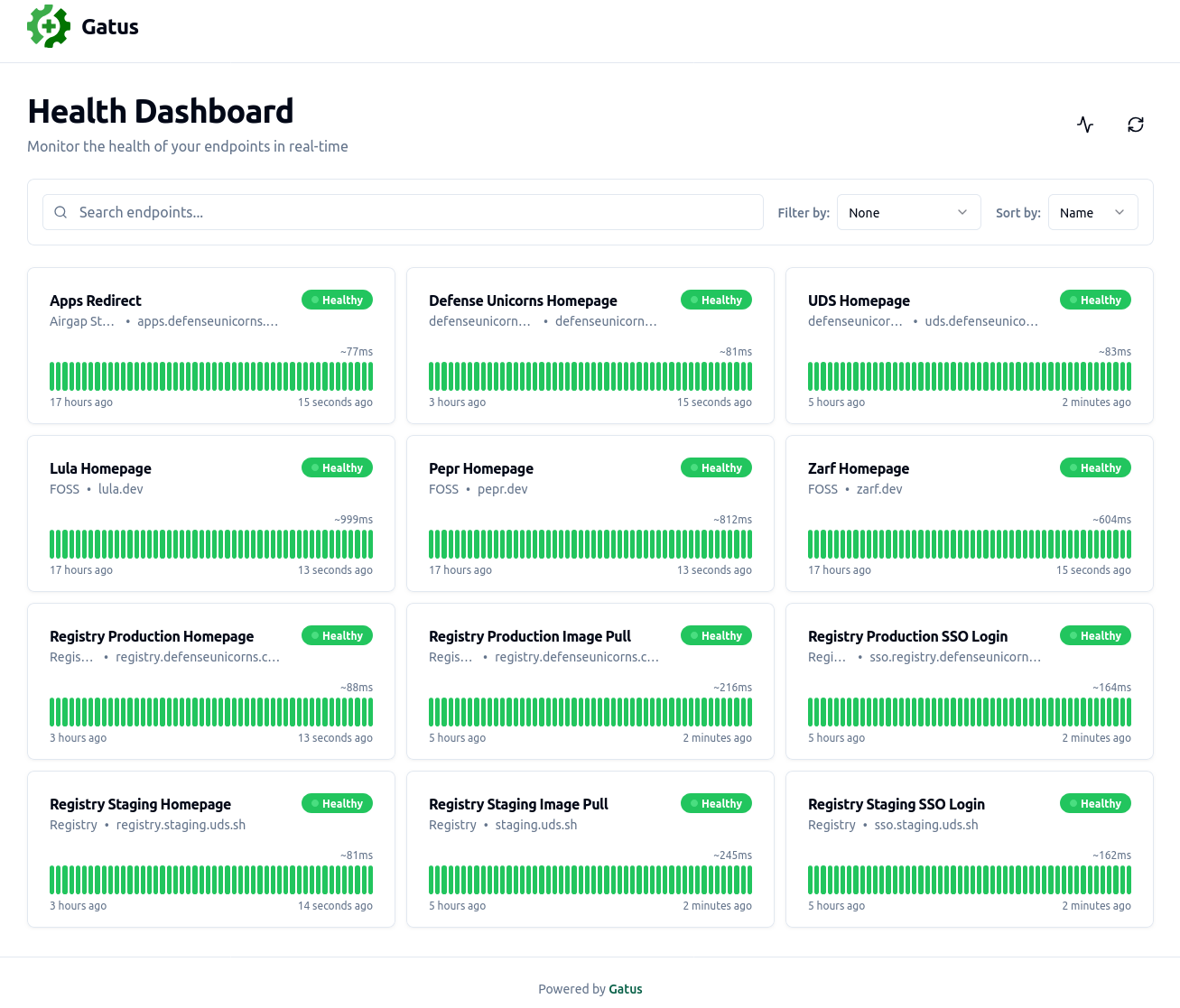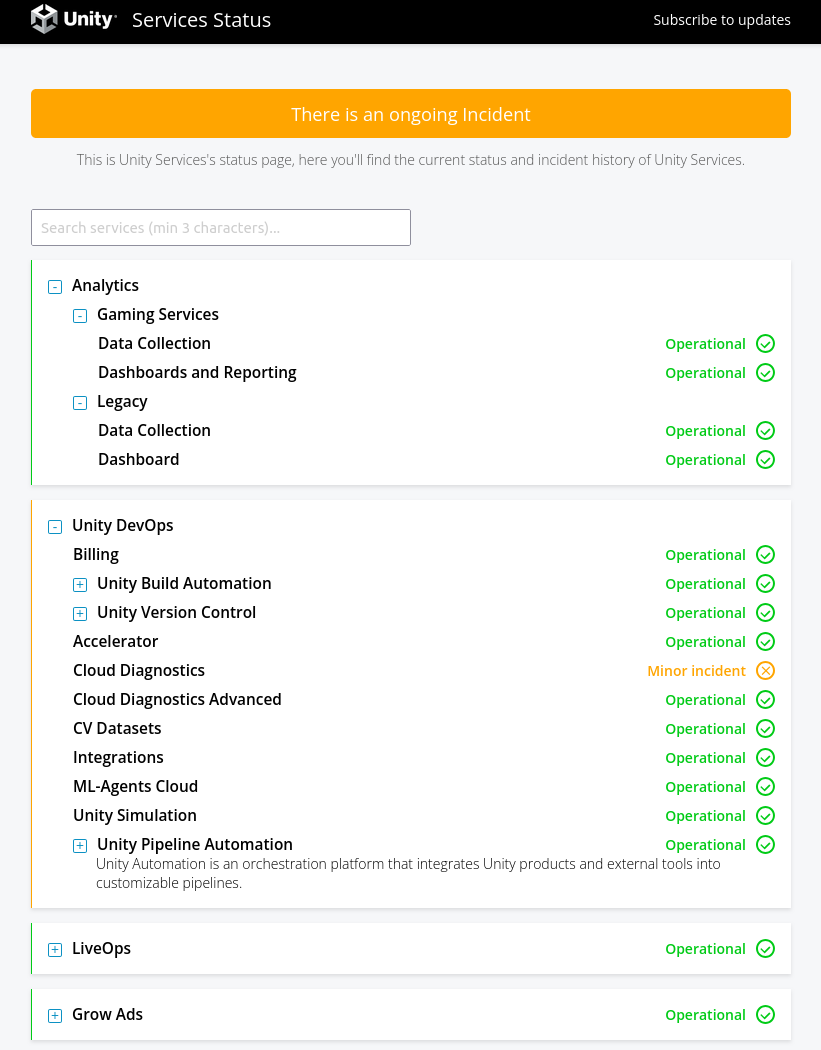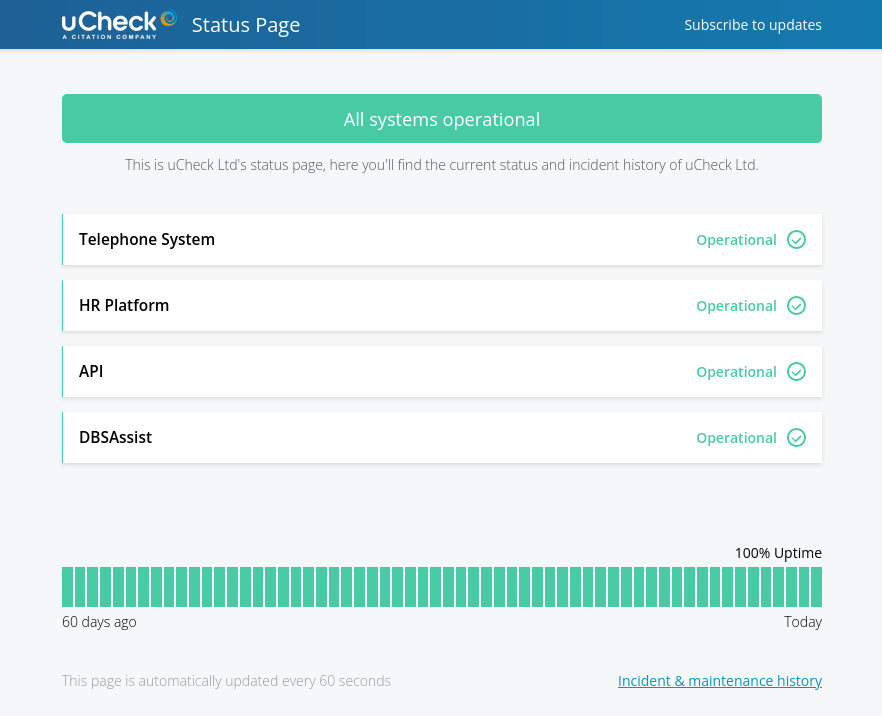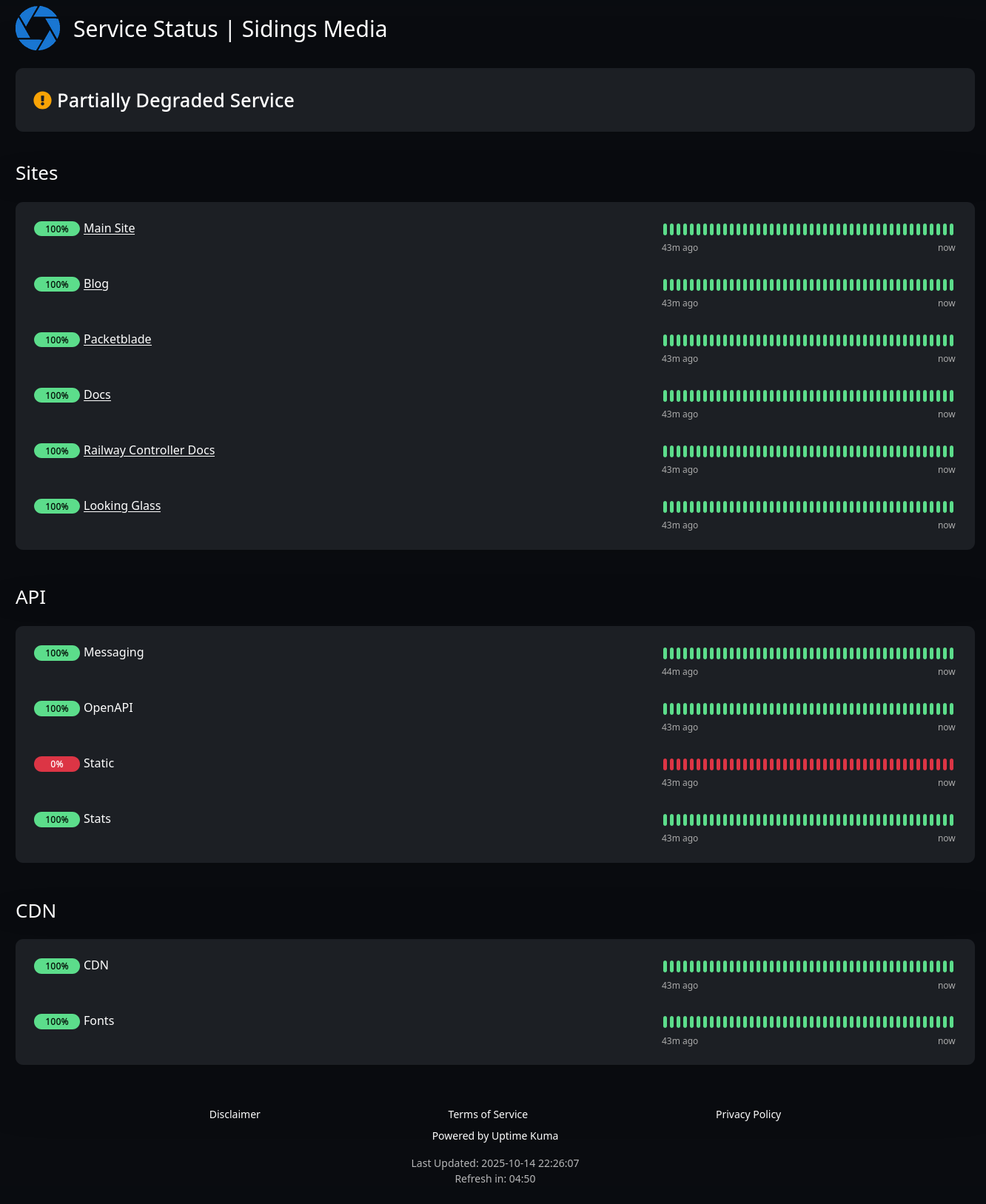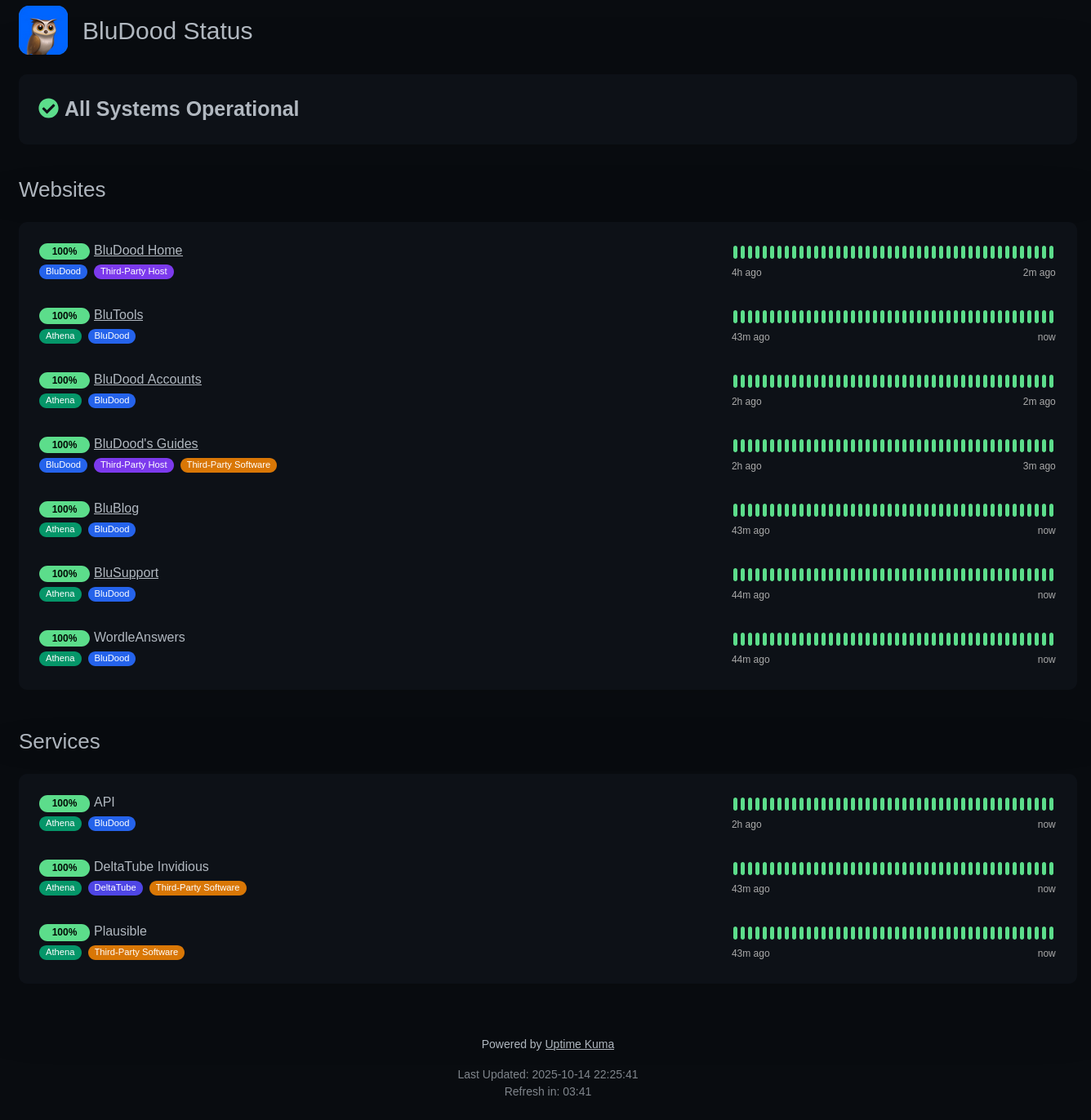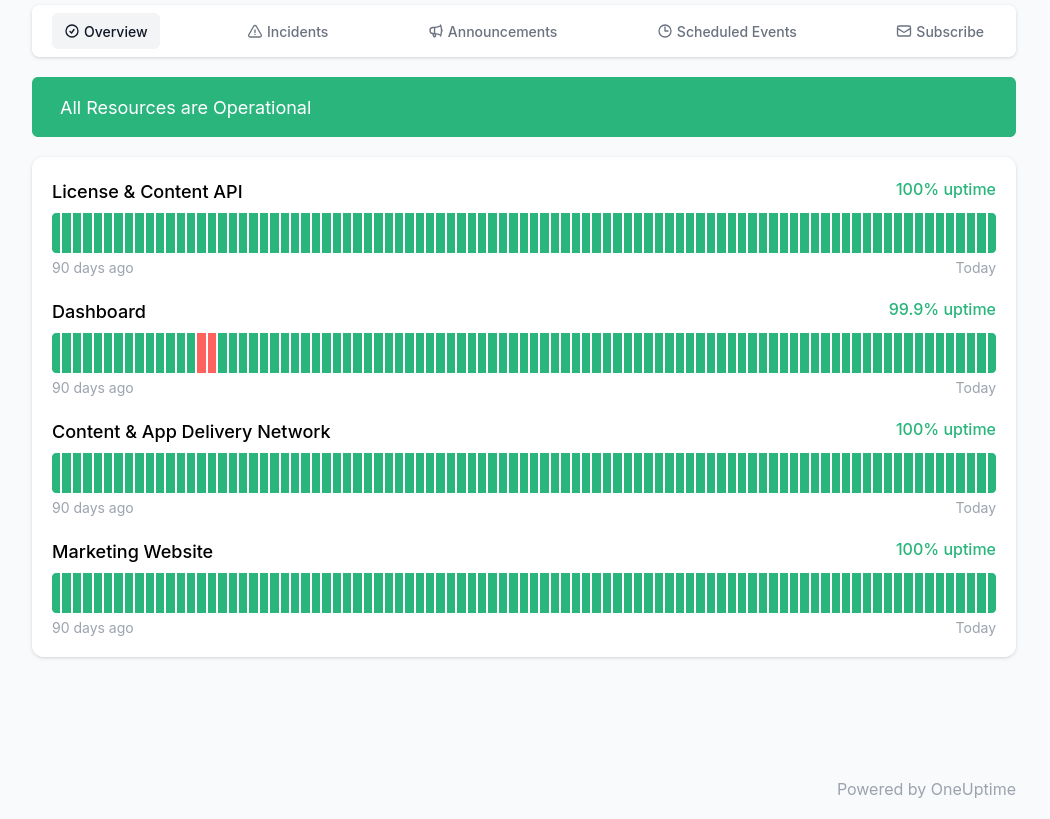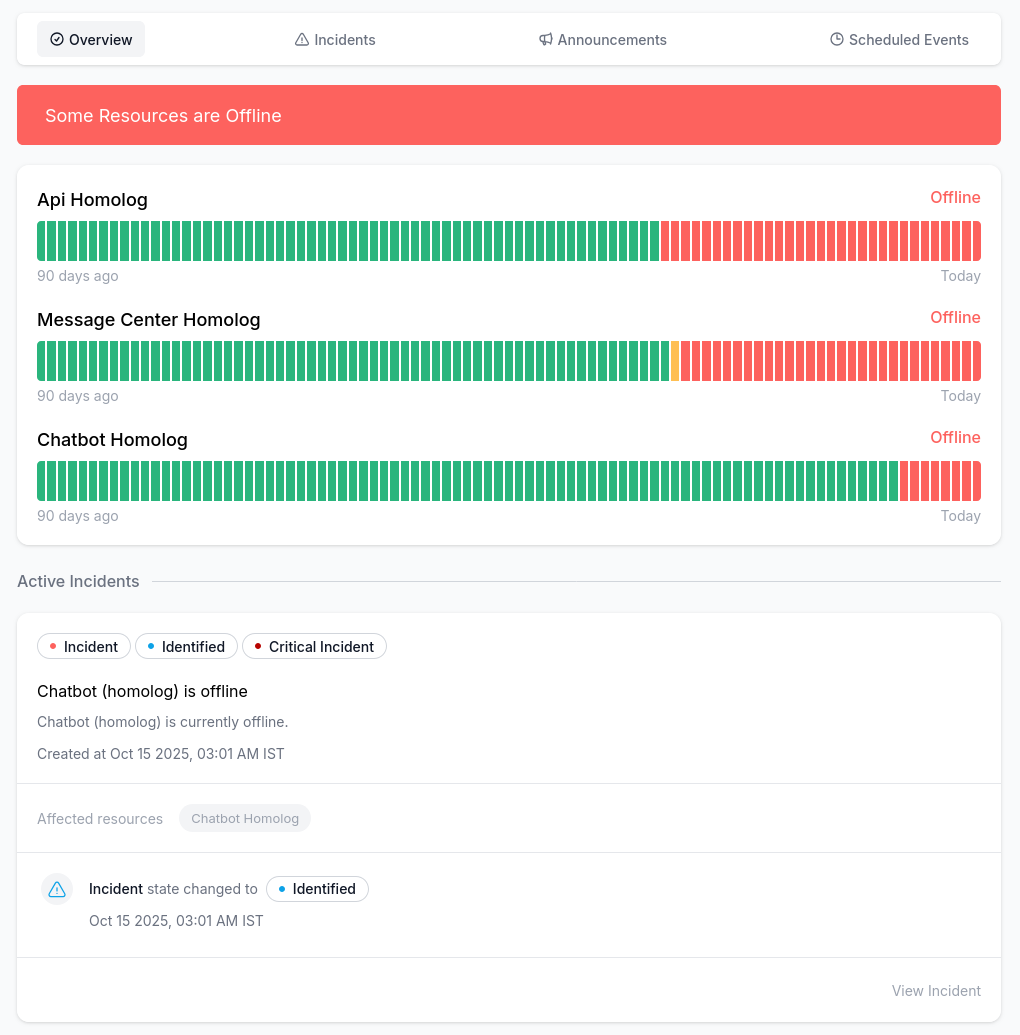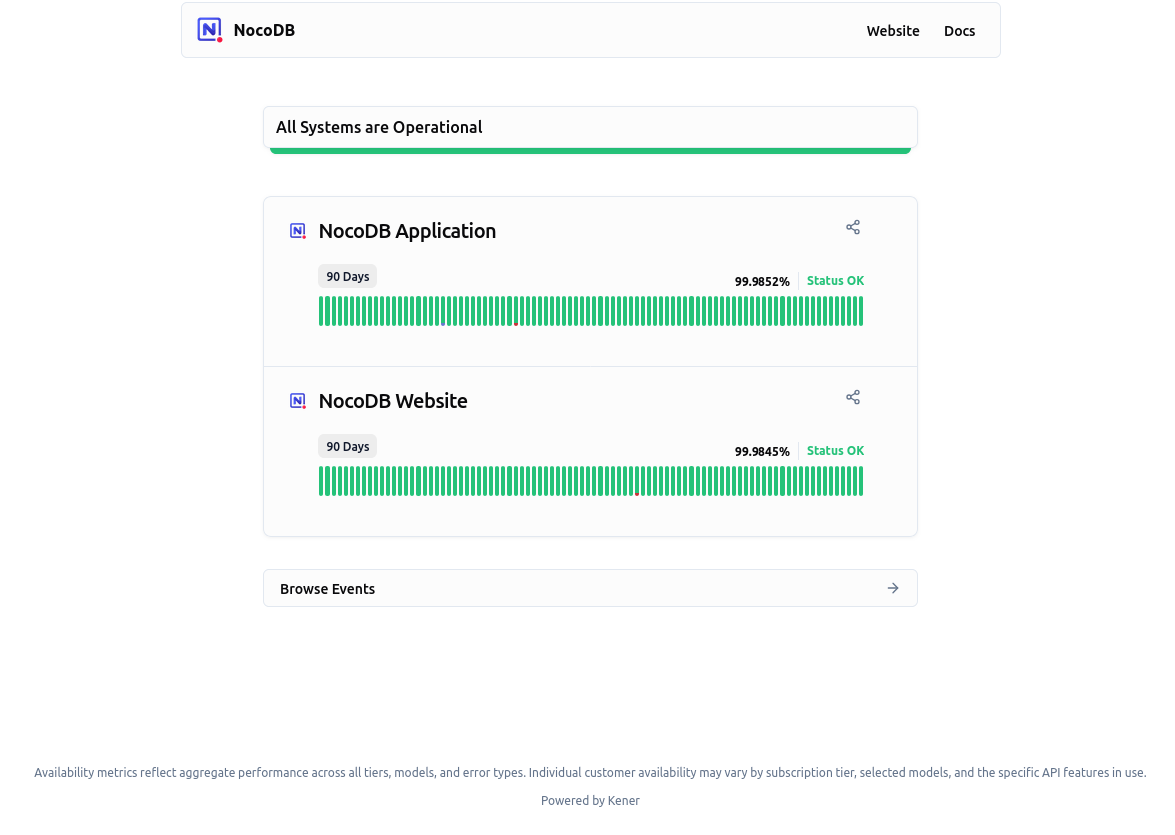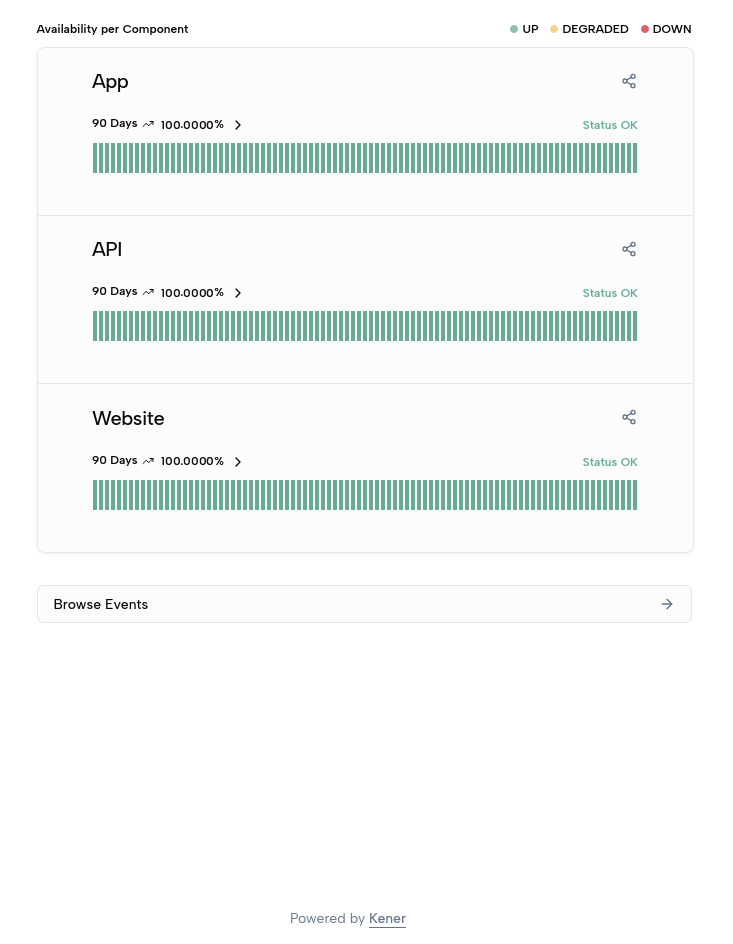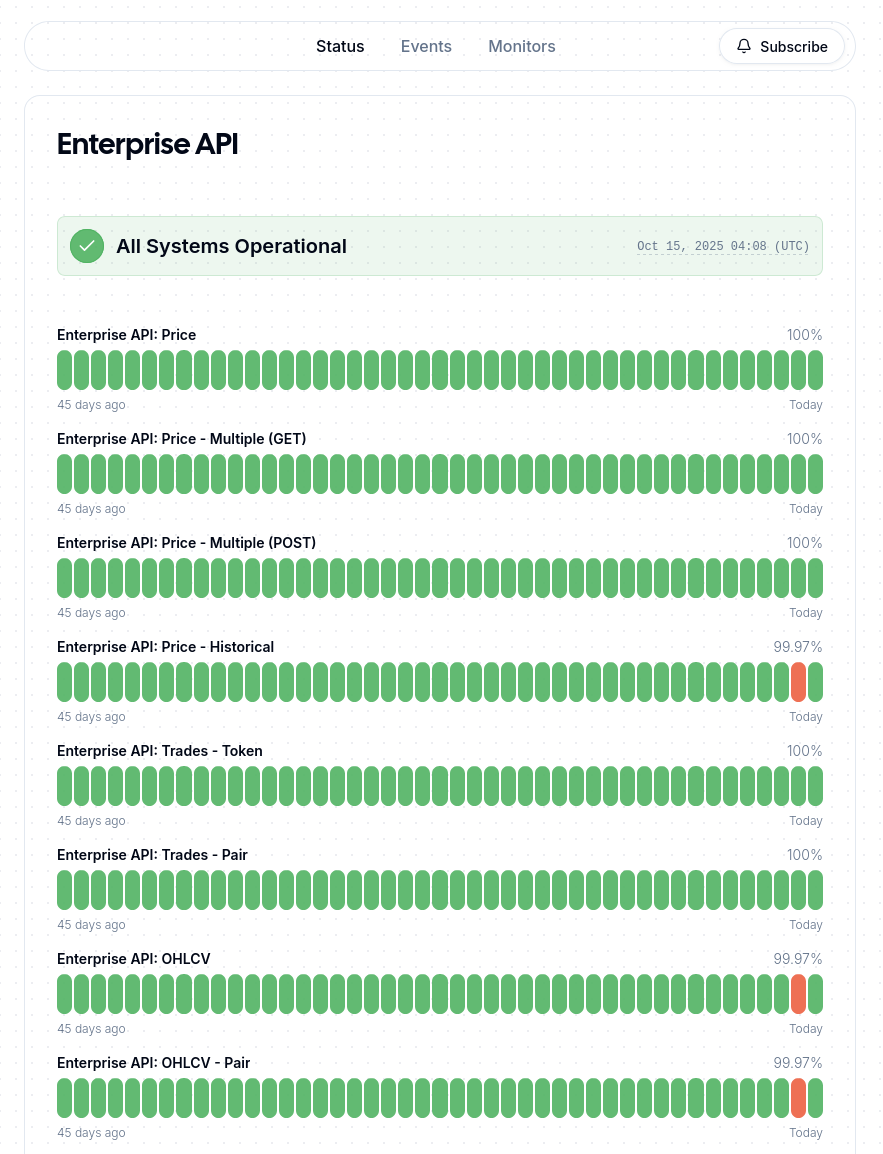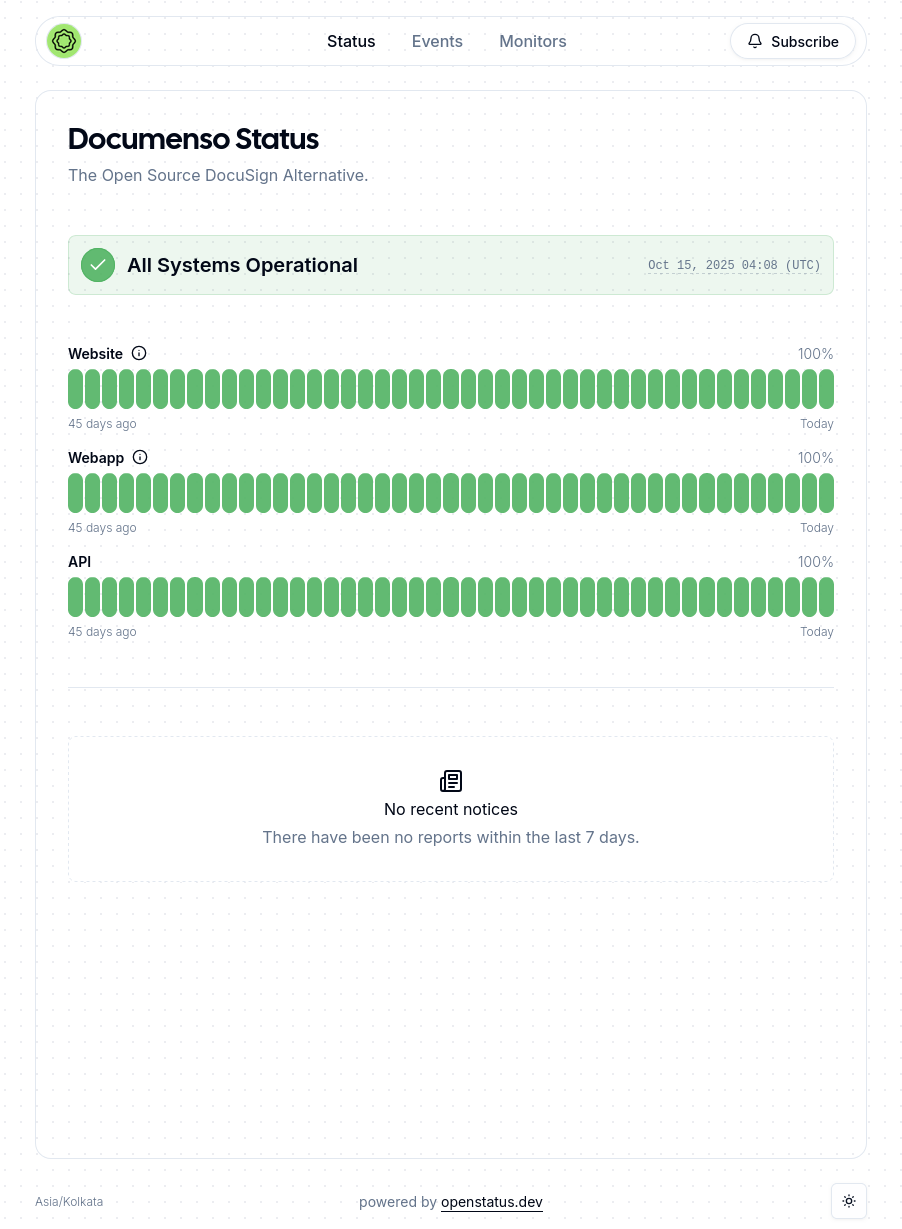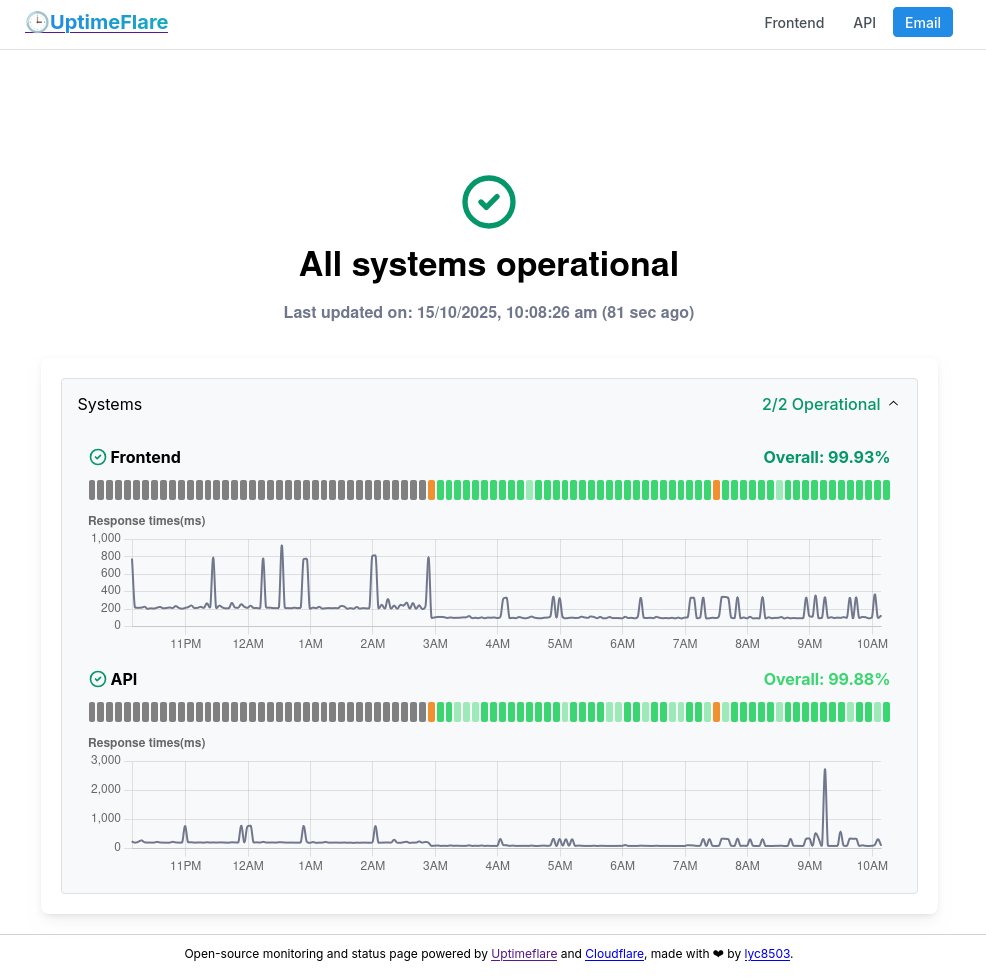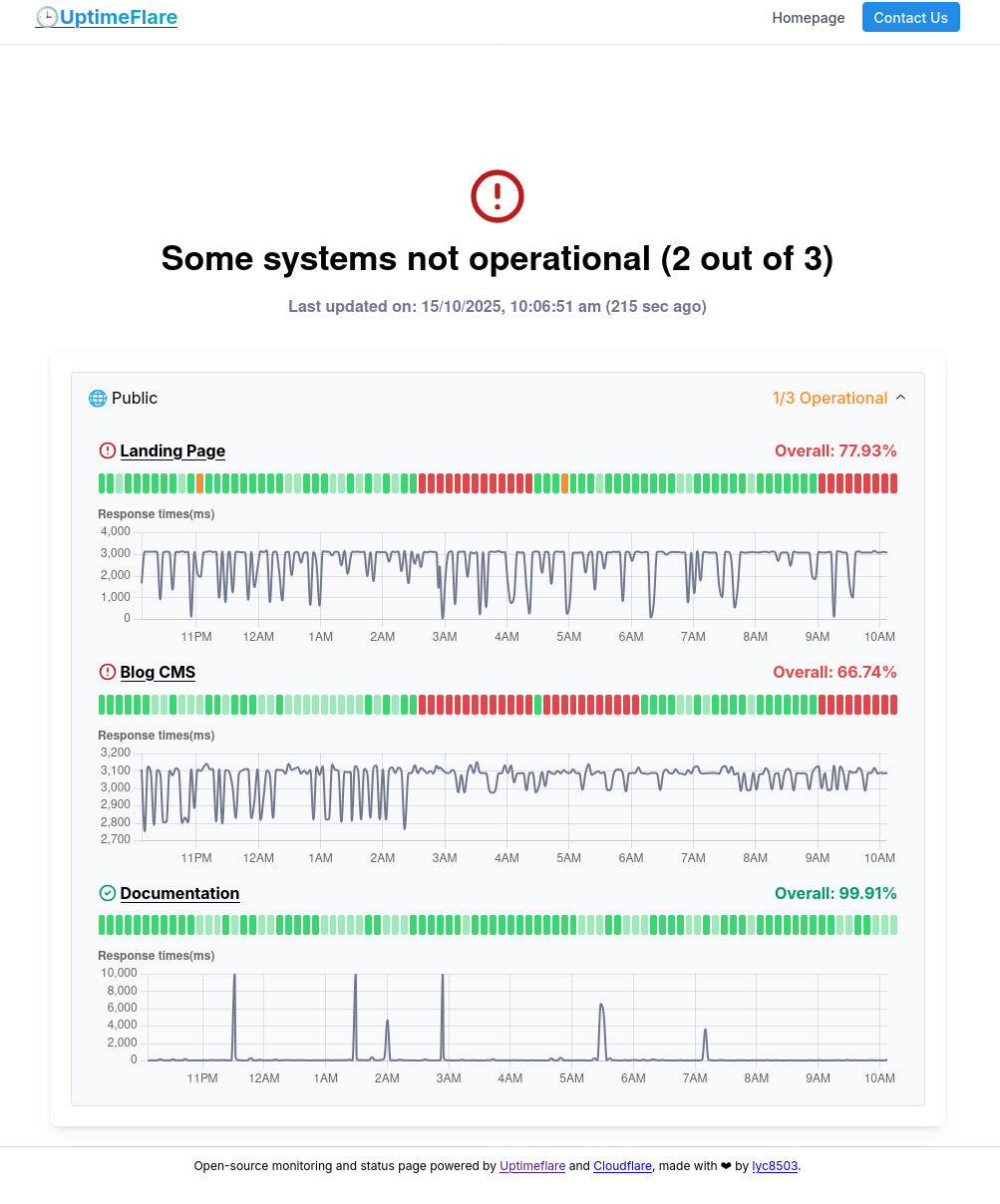The 2025 Guide to Open Source Status Page Software
Introduction
This is an updated version of the 2024 article.
Maintaining transparent communication about service availability is crucial for businesses of all sizes. Status pages are an important part of your communication strategy during times of outages and maintenance events.
You can choose to go with a fully managed status page provider or host an open-source one yourself.
Open source status page software offer a cost-effective and customizable solution where you have complete control over the code, data, and presentation. This guide explores the best available open source status page software in 2025 to help you choose the right tool for your needs.
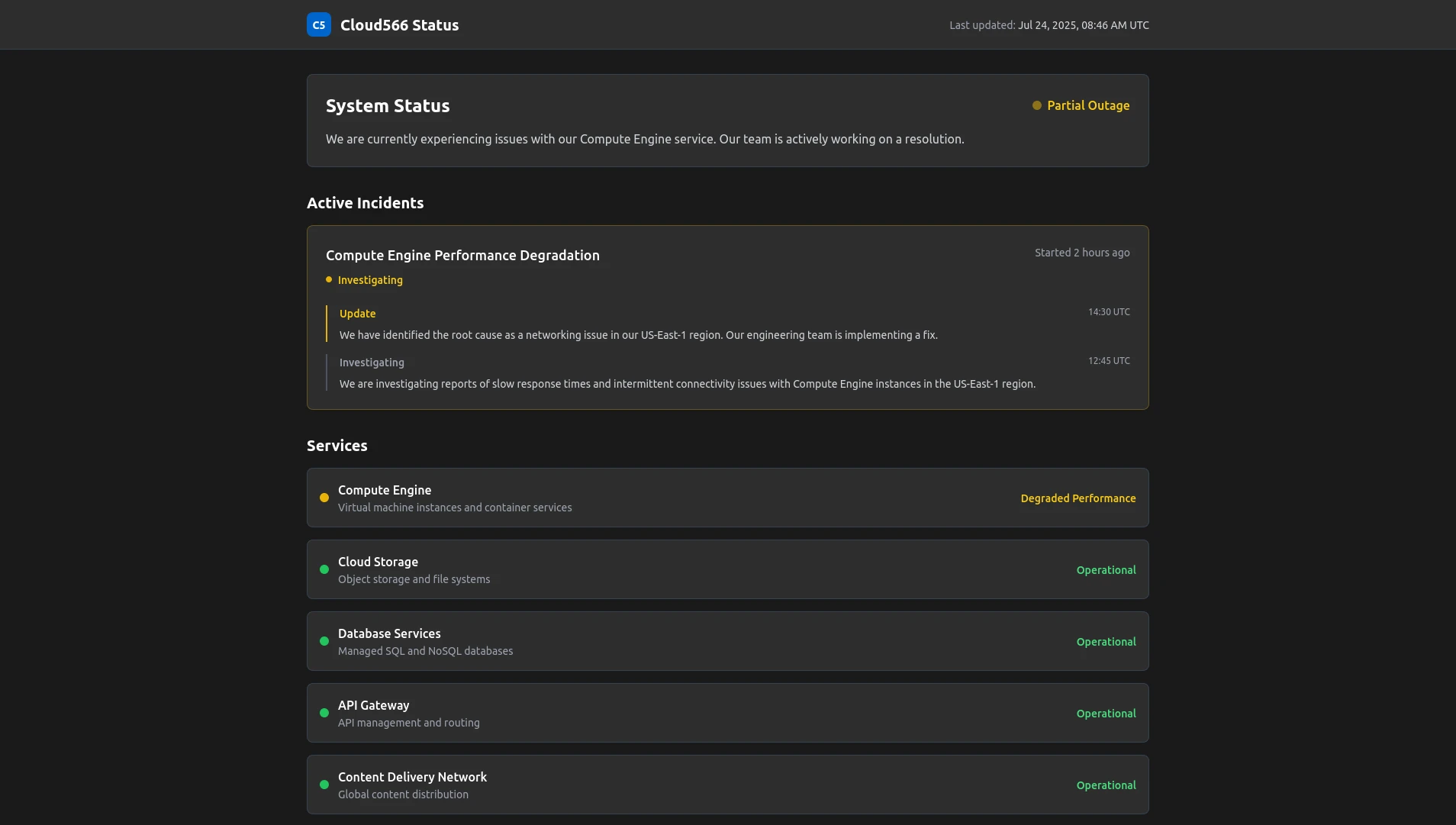
- Introduction
- List of Open Source Status Page Software
- Choosing the Right Open Source Status Page Software
- Summary
- Conclusion
List of Open Source Status Page Software
1. Cachet
Cachet is a popular open source status page system built with PHP and Laravel. It offers a clean, minimalist design and a robust feature set.
Key Features:
- Easy installation and setup.
- Metric graphs for visualizing performance.
- Maintenance scheduling.
- Multilingual support.
- Metrics.
- Service components.
- Two-factor authentication.
- JSON API for automation.
- Subscriber notifications via email.
Home Page: https://cachethq.io/
Source Code: https://github.com/cachethq/cachet
Demo Site: https://v3.cachethq.io/
Managed Version Available: No
Live page examples:
2. Statping-ng
Statping-ng is a Go-based status page that emphasizes simplicity and ease of use. It supports both SQLite and MySQL databases. Statping-ng is an updated replacement of statping after development stopped on the original fork.
Key Features:
- Lightweight and fast.
- Built-in monitoring capabilities for HTTP, TCP, UDP, gRPC, and ICMP.
- Customizable response checks.
- Customizable HTTP checks with headers and body.
- Mobile-friendly design.
- OAuth authentication fro GitHub, Google, and Slack.
- Native mobile apps for Android and iOS.
- Customizable themes.
- Prometheus exporter for advanced monitoring.
- Notifications on Slack, Email, and Twilio.
- Plugin framework.
Home Page: https://statping-ng.github.io/
Source Code: https://github.com/statping-ng/statping-ng
Demo Site: NA
Managed Version Available: No
Live page examples:
3. Cstate
Cstate is a Hugo-based static status page generator that emphasizes simplicity and performance.
Key Features:
- Fast page load times.
- Fully customizable through Hugo templates.
- Supports multiple content formats (YAML, JSON, TOML).
- Multilingual support.
- Automatic light/dark mode.
- Easy deployment to Netlify or GitHub Pages
Home Page: https://cstate.netlify.app
Source Code: https://github.com/cstate/cstate
Demo Site: https://cstate.mnts.lt
Managed Version Available: No
Live page examples:
4. Upptime
Upptime is a GitHub-powered open source uptime monitor and status page generator.
Key Features:
- No server required - runs entirely on GitHub Actions.
- Scheduled maintenance support.
- Workflows integrate with GitHub - issue creation, summary, response graph generation, response time calculation, etc.
- Real-time notifications via GitHub Issues.
- Custom domain and SSL support through GitHub Pages.
- Graphs and badges for displaying uptime.
- Integrates with various monitoring services.
- Notifications via Slack, Telegram, Discord, Zulip, Microsoft Teams, Gotify, Email, SMS, and custom webhooks.
Home Page: https://upptime.js.org
Source Code: https://github.com/upptime/upptime
Demo Site: https://demo.upptime.js.org
Managed Version Available: No, but powered by GitHub Actions.
Live page examples:
5. Vigil
Vigil is a lightweight status page written in Rust, designed for high performance and low resource usage.
Key Features:
- Simple configuration using TOML files.
- Built-in monitoring capabilities for HTTP/TCP/ICMP, application services, and local services (e.g. on a different network away from the main server).
- Support for push notifications.
- Planned maintenance notices.
- Integrates with Email, Twilio (SMS), Slack, Zulip, Telegram, Pushover, Gotify, XMPP, Matrix, Cisco Webex, and Webhooks.
Home Page: https://crates.io/crates/vigil-server
Source Code: https://github.com/valeriansaliou/vigil
Demo Site: NA
Managed Version Available: Crisp offers a managed version of Vigil ported to their own infrastructure.
Live page examples:
6. Gatus
Gatus is a health dashboard and status page that monitors services and endpoints using HTTP, TCP, and other network protocols.
Key Features:
- Inbuilt health checks - HTTP, ICMP, TCP, DNS.
- Condition-based rule evaluation of health query results.
- Support for tunneling to monitor services on a different network.
- Customizable alerting - supports various providers like AWS SES, Discord, Email, Gitea, GitHub, GitLab, Google Chat, Gotify, HomeAssistant, IFTTT, Ilert, Incident.io, Line, Matrix, Mattermost, Messagebird, n8n, New Relic, Ntfy, Opsgenie, PagerDuty, Plivo, Pushover, Rocket.Chat, SendGrid, Signal, SIGNL4, Slack, Splunk, Squadcast, Teams, Teams Workflow, Telegram, Twilio, Vonage, Webex, Zapier, Zulip, etc.
- Customizable alert thresholds.
- Support for announcing planned maintenance.
- Basic auth and OIDC support.
- Metrics visualization.
- Easy to configure using YAML.
- Automatic badge generation for monitored endpoints.
- Docker support for easy deployment.
Home Page: https://gatus.io/
Source Code: https://github.com/TwiN/gatus
Demo Site: https://status.twin.sh/
Managed Version Available: Yes
Live page examples:
7. StatusPal
StatusPal is an Elixir-based status page system. The repository has not been updated in a while as of this writing but they also offer a managed version.
Key Features:
- Email and Tweet notifications.
- Private and public status pages.
- Component support.
- API for integration with monitoring tools.
- Multi-language support.
- Scheduled maintenance announcements.
Home Page: https://statuspal.io/
Source Code: https://github.com/statuspal/statuspal
Demo Site: NA
Managed Version Available: Yes
Live page examples:
8. Uptime Kuma
Uptime Kuma is a monitoring tool with a built-in status page feature.
Key Features:
- Uptime monitoring for HTTP, TCP, DNS, Keywords, Ping, Steam Game Server, Docker Containers.
- Multi-language support.
- 2-factor authentication
- Docker support
- Notifications via Telegram, Discord, Gotify, Slack, Pushover, Email (SMTP), etc
- 20-second intervals
- Multiple status pages
- 2FA support
Home Page: https://uptime.kuma.pet/
Source Code: https://github.com/louislam/uptime-kuma
Demo Site: https://uptime.kuma.pet/
Managed Version Available: No
Live page examples:
9. OneUptime
An observability platform that also has status pages.
Key Features:
- Uptime monitoring.
- Customizable public status pages.
- Notifications via Email, SMS, Slack etc
- Custom branding on your status page.
- On-call policies, schedules and alerts.
- Log management.
- Incident management workflow.
- Application Performance Monitoring.
Home Page: https://oneuptime.com/
Source Code: https://github.com/OneUptime/oneuptime
Demo Site: NA
Managed Version Available: Yes
Live page examples:
10. Kener
Monitoring and status page tool written in Node.js.
Key Features
- Monitoring support for HTTP, DNS, TCP, Ping, SQL, SSL, Heartbeats, Gamedig, etc.
- Quick setup with Docker.
- Dark/light mode support.
- Notification support on Discord, Slack, Email, and Webhooks.
- In-built support for SEO tools.
- Timezone auto-adjustment.
- Role based access control.
- Badge and embded support.
- API based incident creation.
- Customizable branding.
- i18n support.
Home Page: https://kener.ing/
Source Code: https://github.com/rajnandan1/kener
Demo Site: https://kener.ing/
Managed Version Available: No
Live page examples:
11. OpenStatus
A performance monitoring platform written in Typescript and Go with public status pages.
Key Features
- API, DNS, Domain, SMTP, Ping etc monitoring - with latency, uptime, availability metrics.
- OpenTelemetry support for metrics.
- Password protection and custom domain support for status pages.
- Scheduled maintenance support.
- User notification support via Email, SMS, Discord, OpsGenie, PagerDuty, Slack, Ntfy, and Webhooks.
Home Page: https://openstatus.dev/
Source Code: https://github.com/openstatusHQ/openstatus
Demo Site: NA
Managed Version Available: Yes
Live page examples:
12. UptimeFlare
A serverless uptime monitoring tool with a built-in status page.
Key Features
- Serverless uptime monitoring.
- Geo-specific checks.
- HTTP/HTTPS/TCP port monitoring.
- Customizable request methods, body, and headers, and custom status codes and response checks for HTTP.
- Scheduled maintenance support.
- Built-in status page with customizable branding.
- Notifications via Email, SMS, Discord, OpsGenie, PagerDuty, Slack, Webhooks etc. using the Apprise library.
- Password protection for status pages.
- JSON API for status data.
Home Page: https://uptimeflare.pages.dev/
Source Code: https://github.com/lyc8503/UptimeFlare
Demo Site: https://uptimeflare.pages.dev/
Managed Version Available: No
Live page examples:
Choosing the Right Open Source Status Page Software
When selecting an open source status page software, consider the following factors:
- Ease of installation and maintenance.
- Compatibility with your existing tech stack.
- Customization options and flexibility.
- Community activity and long-term support.
- Integration capabilities with your monitoring tools.
- Performance and scalability.
- Notification and alerting options.
- Historical data retention and display.
- User management and access control.
To elaborate on #5 - some of these status pages are part of a bigger monitoring toolkit where the status data is drawn from the same toolkit's monitors. If the status page does not support data from other sources you might not be able to use only the status page feature in such tools. Others are standalone status pages - where you can push incident events from anywhere you want. This is an important factor to keep in mind.
Summary
Conclusion
Open source status page software offer a cost-effective way to keep your users informed about your service's health and performance. By choosing the right tool from this guide, you can enhance transparency, build trust with your users, and streamline your incident communication process.
This article was first published on the IncidentHub blog.

